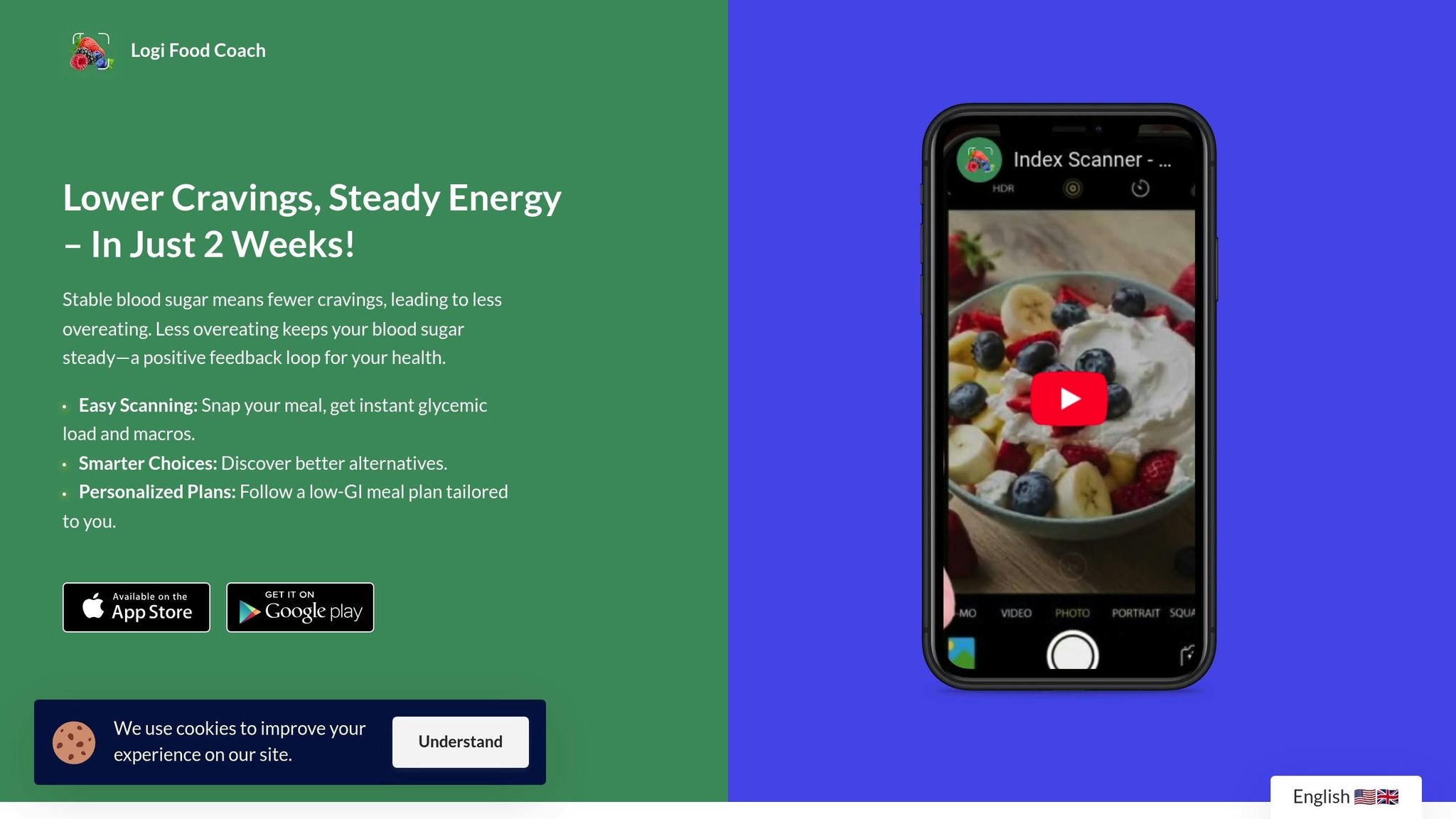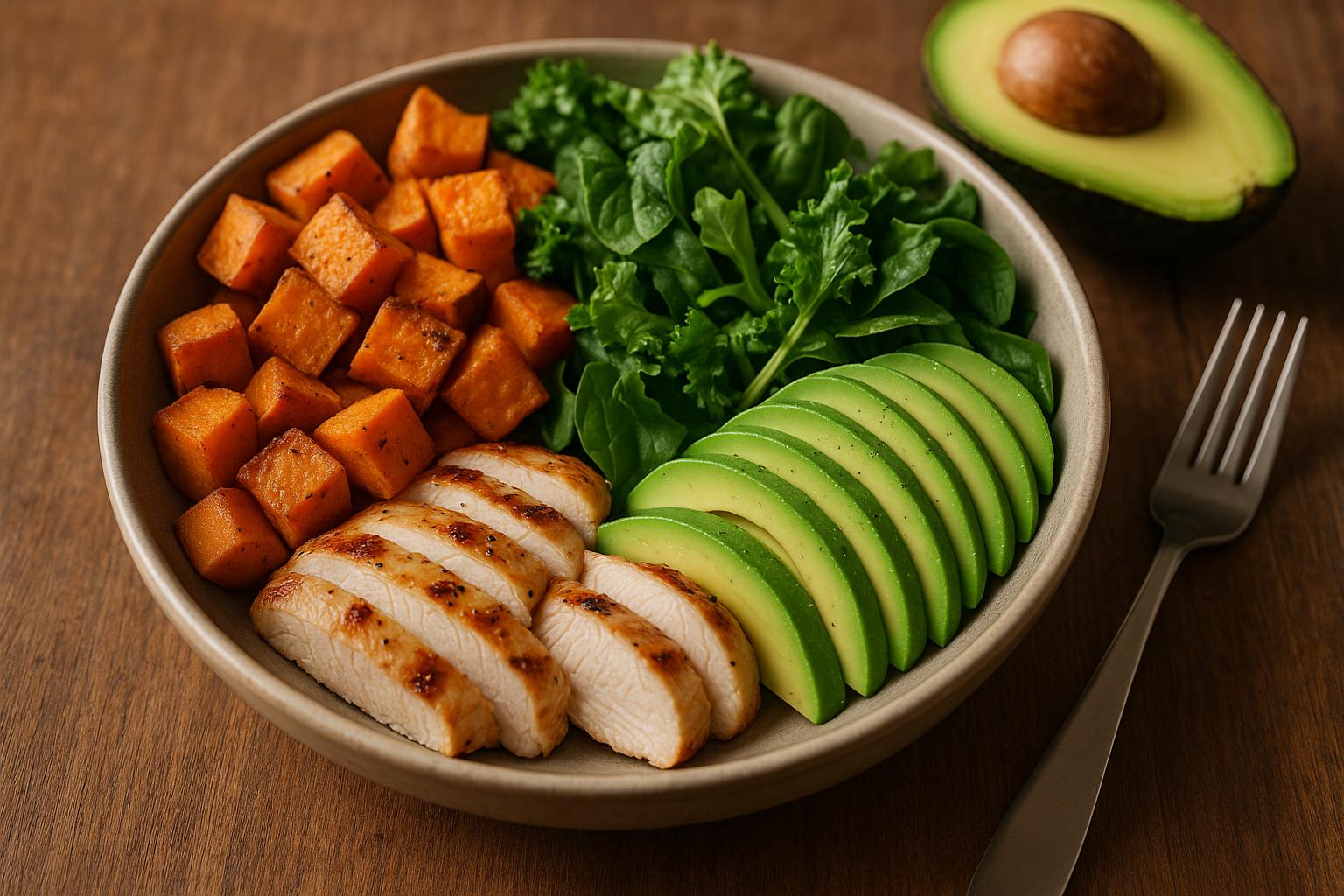Eating seasonally is one of the easiest ways to improve blood sugar control. By focusing on fresh, in-season produce, you can stabilize glucose levels, lower A1C, and enjoy nutrient-packed meals that taste great. Seasonal meal prep also helps you save money, reduce food waste, and support local farms.
Key Insights:
- Seasonal Foods: Fresh produce harvested at its peak provides more nutrients that help regulate blood sugar.
- Blood Sugar Benefits: Seasonal eating can lower hemoglobin A1C and reduce diabetes risk by 27%.
- Meal Prep Tips: Use the Diabetes Plate Method (50% non-starchy veggies, 25% lean protein, 25% complex carbs) for balanced meals.
- Seasonal Variations: Glycemic index and load of foods can change with ripeness and seasonality - choose wisely.
- Preservation Methods: Freezing and fermenting seasonal produce maintain nutrients and extend shelf life.
Seasonal Highlights:
- Spring: Spinach, asparagus, radishes - low GI, fiber-rich options.
- Summer: Berries, zucchini, cucumbers - refreshing and glucose-friendly.
- Fall: Sweet potatoes, squash - fiber-packed for steady energy.
- Winter: Kale, Brussels sprouts, citrus - immune-boosting and blood sugar-friendly.
For a smarter way to track and plan seasonal meals, tools like the Logi App can help monitor glycemic load, suggest alternatives, and create tailored meal plans. Pair seasonal eating with thoughtful prep to maintain steady blood sugar all year.
How Seasonal Foods Affect Blood Sugar
Seasonal Foods and Blood Sugar Management
Fresh, in-season produce harvested at its peak offers nutrients that can help stabilize blood sugar levels. For example, leafy greens can lose up to 50% of their vitamin C content during transport and storage, which may influence how the body responds to sugar.
"Fruits and vegetables that are stored for long periods of time due to transportation or to be used at a later date have a reduction in phyto-nutrient content." - Joe Cross, Health and Wellness Advocate
A 2019 study revealed that adults with prediabetes who ate 2 cups (about 250 g) of fresh red raspberries alongside high-carb meals showed significantly lower post-meal insulin and blood sugar levels compared to those in a control group. This highlights how nutrient levels in fresh, seasonal foods can directly affect the glycemic index (GI) and overall blood sugar impact.
Glycemic Index Changes by Season
The glycemic index and glycemic load of fruits and vegetables can vary depending on the season, ripeness, and freshness. Here's a quick comparison of common seasonal produce:
| Food Type | Glycemic Index | Glycemic Load (per serving) | Best Season |
|---|---|---|---|
| Watermelon | 72 | 4 | Summer |
| Apple | 39 | 6 | Fall |
| Orange | 40 | 4 | Winter |
| Carrots | 35 | 2 | Year-round |
Ripeness plays a significant role in a food's glycemic index. For instance, a slightly underripe banana has a lower GI, but as it ripens, its GI increases to 62, with a glycemic load of 16 per serving. Similarly, winter vegetables like parsnips have a moderate GI of 52 and a glycemic load of 4 per serving, while summer produce like watermelon, despite its high GI, has a low glycemic load.
Eating seasonally not only diversifies your nutrient intake but also supports better blood sugar control by providing a variety of vitamins, minerals, and phytonutrients.
"Eating seasonal foods can contribute towards a healthy diet and can help the local environment and our farming industry." - Caroline Spelman, Secretary of State
For effective blood sugar management, focus on both glycemic index and glycemic load. Foods with a glycemic load under 10 are considered low impact, while those over 20 are high impact. By understanding how seasonal variations affect these values, you can make more informed choices for meal planning.
The Consistent Carbohydrate Diet – Seasonal Eating and Blood Sugar Control with Dr. Christina Desai
Meal Prep Methods for Blood Sugar Balance
Meal prep plays a key role in keeping blood sugar levels steady. By using thoughtful preparation and storage techniques, you can create meals that help maintain balanced glucose levels all year round.
Bulk Prep and Storage Tips
Preparing meals in bulk with a mix of protein, non-starchy vegetables, and measured complex carbohydrates allows you to see how different food combinations affect your blood sugar.
A helpful guideline to follow is the Diabetes Plate Method:
| Portion | Food Type | Prep Examples |
|---|---|---|
| 50% | Non-starchy vegetables | Chopped bell peppers, broccoli, carrots |
| 25% | Lean protein | Grilled chicken, baked tofu, fish |
| 25% | Complex carbohydrates | Quinoa, brown rice, sweet potatoes |
To keep your ingredients fresh throughout the week, store them in airtight, BPA-free containers. Once prepped, these components can be combined into meals that promote steady blood sugar levels.
Combining Foods for Better Blood Sugar Control
When assembling your meals, aim for a balance of fiber-rich vegetables, lean protein, healthy fats, and measured complex carbohydrates. Research from a 7-day spring meal plan revealed that consuming about 33 grams of fiber and 116 grams of protein daily supports stable glucose levels. Additionally, prepping snacks rich in fiber and protein can help manage blood sugar between meals.
Preserving Seasonal Foods
Proper preservation of seasonal produce ensures it retains its nutrients, which are essential for blood sugar control. Studies suggest that frozen vegetables can maintain more nutrients over 12 months compared to fresh produce stored at 39°F for just one week.
Here are two effective preservation methods:
- Freezing: Wash and dice fruits, adding a splash of lemon juice to prevent browning. Blanch vegetables before freezing, and aim to use them within 8–10 months.
- Fermentation: Submerge vegetables in a brine solution for fermentation. This process not only preserves the food but also enhances compounds that help regulate blood sugar.
"Proper food preservation means maintaining its quality and nutritional value, plus appropriately sealing it to prevent contamination by pathogens or chemicals." - Mirela Cojoaca
Fermented vegetables offer added benefits, including short-chain fatty acids, minerals, and polyphenols. Additionally, the vinegar-based brine in pickled vegetables can help stabilize glucose levels.
sbb-itb-0899721
Season-by-Season Food Guide and Recipes
Building on smart meal prep strategies, these seasonal recipes make the most of fresh produce to help keep blood sugar levels in check.
Spring: Low-GI Meals with Greens
Spring brings a bounty of low-glycemic vegetables that are perfect for managing blood sugar. Here are some top picks and how they work:
| Main Ingredients | Complementary Foods | Blood Sugar Benefits |
|---|---|---|
| Spinach | Lean protein, olive oil | Packed with fiber, low in carbs |
| Watercress | Eggs, nuts | Full of essential minerals |
| Asparagus | Lemon, garlic | Minimal glycemic impact |
| Radishes | Greek yogurt dip | Aids in detoxification |
Spring Recipe: Mediterranean Asparagus Bowl
- Base: 2 cups fresh spinach
- Protein: 4 oz grilled chicken
- Vegetables: 8 asparagus spears, 4 radishes
- Healthy Fats: 1 tablespoon olive oil, ¼ avocado
- Seasoning: Fresh lemon juice, garlic, and herbs
This vibrant dish is light yet satisfying, making it a great choice as the weather starts to warm up.
Summer: Light Meals with Berries
Summer is the season for naturally sweet, low-GI produce that’s both refreshing and nourishing.
Top Summer Produce:
- Strawberries, raspberries, blueberries
- Zucchini
- Cucumber
- Snow peas
- Fresh tomatoes
Pair these ingredients with lean proteins and healthy fats for meals that energize without spiking blood sugar. For instance, a Summer Berry Protein Bowl combines Greek yogurt, mixed berries, and a sprinkle of nuts for a balanced, cooling option.
Fall: Root Vegetable Dishes
Fall’s earthy flavors come from fiber-rich root vegetables, which pair beautifully with proteins and healthy fats to support blood sugar stability.
Blood Sugar-Friendly Fall Recipe: Roasted Root Medley
- Veggies: 1 cup cubed butternut squash, 1 medium sweet potato (cubed), 1 cup sliced carrots
- Healthy Fats: 2 tablespoons olive oil
- Protein: 4 oz turkey or tempeh
- Herbs: A mix of rosemary, thyme, and sage
Roasting these vegetables brings out their natural sweetness while keeping their glycemic load low.
"Meal prepping is a valuable strategy for individuals managing diabetes, providing a convenient and consistent way to stick with your healthy eating plan while juggling a busy schedule."
– Emily Weeks, RDN, LD
Winter: Citrus and Green Vegetable Meals
Winter produce can be a game-changer for blood sugar management when paired with greens and lean proteins.
Winter Produce Pairings:
- Kale with oranges and walnuts
- Brussels sprouts with pomegranate seeds
- Cauliflower with a citrus vinaigrette
- Purple sprouting broccoli with garlic
To retain their fiber content, try steaming or roasting these vegetables. Pair them with proteins like fish or legumes for complete, balanced meals. These dishes also work seamlessly with tools like the Logi app, which helps you track blood sugar levels with precision.
Using Logi - Glycemic Index Tracker App for Seasonal Planning

When it comes to seasonal meal prep, the Logi - Glycemic Index Tracker App is like having a personal nutrition coach in your pocket. It combines advanced tools with easy-to-use features to help you manage blood sugar levels and make smarter food choices throughout the year.
Measuring Seasonal Food Impact
Curious about how your seasonal dishes stack up nutritionally? Logi’s glycemic load scanner makes it simple. Just snap a picture of your meal, and the app’s AI food scanner breaks down the nutritional content and glycemic load in seconds.
Here’s how it helps:
| Seasonal Feature | Function | Benefit |
|---|---|---|
| AI Food Scanner | Analyzes meal photos | Instant nutritional breakdown |
| Barcode Scanner | Scans packaged foods | Quick glycemic load assessment |
| Alternative Finder | Suggests lower GI options | Healthier seasonal substitutions |
These tools make it easier to understand the glycemic impact of your seasonal favorites and adjust accordingly.
Creating Seasonal Meal Plans
Logi also simplifies meal planning with customizable tools that cater to your dietary needs and goals. Whether you’re managing blood sugar or just trying to eat healthier, the app offers balanced meal plans ranging from 1,250 to 2,500 calories daily. It’s all about creating menus that work for you.
Some standout features include:
- Filters: Tailor your meals to fit preferences like vegan, sugar-free, or dairy-free diets.
- Global Cuisine: Get inspired with dishes from Mediterranean, East Asian, Nordic, and American traditions.
- Portion Control: Adjust serving sizes to match your caloric and nutritional needs.
- Alternatives: Swap high-GI seasonal ingredients for lower glycemic options.
With these tools, you can design meal plans that fit your lifestyle and keep your blood sugar stable.
Tracking Seasonal Blood Sugar Patterns
Once your meal plan is in place, Logi helps you track how seasonal foods affect your blood sugar. By integrating with continuous glucose monitoring (CGM) technology, the app provides real-time insights into your body’s responses. You’ll gain a deeper understanding of key factors like:
- How specific foods influence your glucose levels in real time
- The effect of seasonal activities on blood sugar
- Connections between sleep, stress, and glucose stability
- The role of hydration in maintaining steady blood sugar levels
"Logi provides detailed insights into the glycemic index and glycemic load of your food, enabling better blood sugar management. Whether you're aiming to stabilize energy levels or reduce cravings, this feature keeps your health in check." - Logi - Glycemic Index Tracker
With an impressive 4.7 out of 5 rating on the App Store, Logi’s tracking system empowers you to spot patterns in your body’s response to seasonal changes. It’s a game-changer for anyone looking to improve their meal planning and overall health year-round.
Conclusion: Managing Blood Sugar Year-Round
Seasonal meal prep plays a key role in maintaining steady blood sugar levels throughout the year, and combining it with practical strategies and modern tracking tools can make a real difference.
Research highlights that cooking at home often leads to healthier eating habits, with better quality food, fewer calories, and improved weight control compared to relying on pre-packaged meals. Incorporating seasonal foods into your diet adds another layer of benefit. These foods not only deliver peak nutritional value but also naturally support blood sugar regulation.
"Eating with the seasons is a simple way to elevate your diabetes care." - Whitney Winn
Here’s how you can align your meals with the seasons for better blood sugar control:
| Season | Key Strategy | Blood Sugar Benefits |
|---|---|---|
| Spring | Fresh greens and fiber-rich vegetables | Supports natural blood sugar balance |
| Summer | Light meals with seasonal berries | Helps maintain steady glucose levels |
| Fall | Root vegetables paired with proteins | Slows digestion and reduces spikes |
| Winter | Citrus fruits and warming vegetables | Provides sustained energy release |
Pairing seasonal eating with thoughtful meal prep and tools like Logi can help you stay on top of your blood sugar management all year long. For instance, studies show that eating three servings of whole grains daily can significantly lower the risk of chronic diseases.
But it's not just about food. A well-rounded approach to blood sugar management includes reducing stress and staying physically active. Tools like Logi make it easier to track these elements alongside your meal plans, offering a full picture of your health and helping you maintain stable blood sugar levels no matter the season.
FAQs
How can eating seasonal foods help manage blood sugar levels?
Eating with the seasons isn't just a treat for your taste buds - it can also help keep your blood sugar steady. Take sweet potatoes in the fall or leafy greens in the spring, for example. These seasonal staples often have a lower glycemic index, meaning they release glucose into your bloodstream at a slower pace. This helps avoid those sudden blood sugar spikes and crashes.
On top of that, seasonal fruits and vegetables tend to be fresher and packed with more nutrients, including essential vitamins and fiber. These nutrients play a key role in improving insulin sensitivity, making it easier for your body to regulate blood sugar. Adding seasonal produce to your meals is a simple way to boost energy and support your metabolic health over the long haul.
How can I preserve seasonal produce while keeping its nutrients intact?
If you're looking to keep seasonal fruits and vegetables fresh while holding onto their nutritional goodness, here are a few easy ways to do it:
- Freezing: Freeze your produce when it's at its best - ripe and full of flavor. For vegetables, a quick blanch in boiling water before freezing helps maintain their color, texture, and taste.
- Dehydrating: Use a dehydrator or set your oven to a low temperature to remove moisture from fruits and veggies. This method not only extends their shelf life but also keeps most of their nutrients intact.
- Canning: Store your produce in jars to keep it from spoiling. While some vitamins that are sensitive to heat may be reduced, canning still preserves the majority of nutrients and is a great option for long-term storage.
These methods let you savor seasonal produce all year while keeping their health benefits largely intact.
How does the Logi app help with seasonal meal prep to manage blood sugar levels?
The Logi app takes the hassle out of seasonal meal planning by helping you design and track meals that promote stable blood sugar levels. With its meal-scanning feature, you can quickly check the glycemic load of your food, keep tabs on your daily eating habits, and dive into a detailed nutritional breakdown of your choices.
The app also highlights low GI/GL food alternatives and suggests healthier seasonal ingredients. This makes it easier to craft balanced meals that suit your lifestyle. It's a straightforward tool for managing your nutrition and maintaining steady energy levels all year long.



